Back to Home
Information from Scott Lichtsinn KBØNLY, Ric Letson NB2E, Skip Chestnut KC2MCV, and Duane Park N6DSP
|
Up one level (Moto Index) Back to Home |
The Motorola Saber Information Page Information from Scott Lichtsinn KBØNLY, Ric Letson NB2E, Skip Chestnut KC2MCV, and Duane Park N6DSP |
|
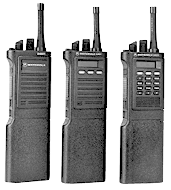
UHF Motorola Sabers I, II and III
Mid band and VHF high band models look the same except for the antenna length.
There are several different length batteries available.
(anybody have a better photo?)
If anyone would like to provide information to update this web page please send it to the page maintainer listed above.
Introduction:
The original Saber family was develped for the US military around 1989, and is noted for its long, thin shape. The Saber receiver probably has the best selectivity that has ever been seen in a portable. These handhelds are tough, popular radios still in use in the military / industrial / public service / commercial and private user environment. The basic Saber and the more advanced Systems Saber were officially labeled obsolete and Motorola depot repair for them ended 31 Dec 2005. The Astro Saber product line was discontinued as of 31 Dec 2002. Accessories for the Astro Saber will be supported through 2008, and the Systems Saber and original Saber use many of those. Because of abandonment of the Saber line, and the upcoming narrowbanding rules they are being replaced by the MTS and XTS series (note that the Astro Saber will do narrowband, the Saber will not). As a result we are seeing a LOT of surplused Sabers and they are relatively inexpensive on the used market plus they are available from several sources (you can find VHF or UHF 12 channel Saber 1s for US$50-$100). With that in mind, it's time to discuss the advantages and disadvantages of the various Saber models, some of which sold for US$3,000 new (or US$4,000 for a trunked, encrypted Astro Saber).
Note that "Astro" is Motorola's marketing name for a digital radio. "Astro" digital modulation originally was a proprietary format and NOT even close to P25. There are later versions of "Astro" that will do P25 (introduced around 1996), but basic "Astro" does not. Neither VSELP (Vector Sum Excited Linear Prediction) or IMBE (Improved Multi-Band Excitation) digital modulation is similar to P25 or have been produced and supported by Motorola since late 1995. Since 1996 the only digital mode from motorola on the Astro line be it portable or mobile has been P25). Astro25 is the Motorola name for the P25 digital modulation in an Astro radio.
There is a consistent rumor that the XTS3000 is a repackaged Astro Saber with a few updates, one of which is a microprocessor with a larger address space. That increased memory space allowed the addition of some additional features.
Back to the Saber...
There are several series of handheld radios in Motorola's Saber line. These
include the original Saber I, the Saber IE, the Saber II and the Saber III,
the Astro Saber family, the Saber SI family, Systems Saber
family (which offers trunked models) and the SSE5000. It's not unusual to
see the I / IE / II / III written as 1, 1E,
2 and 3, especially on eBay auctions. If you are earching for a particular
radio, like a Saber III, make sure that you search for both forms (i.e. both
Saber III and Saber 3).
The MX1000, MX2000 and MX3000 are the export version of the Saber I, II and III, with the only major difference being the model tags on the case, and the firmware in the microprocessor (this means that the Saber accessories will work). Two changes in the firmware are that (1) they do not support the non-exportable encryption modules and (2) they can only be programmed with the MX1000 / 2000 / 3000 RSS.
The basic differences:
The Saber series is very ham-friendly. The Saber II and III have handy features such as MPL (Multiple PL select), nuisance delete - the temporary deletion of a busy channel from the scan list (a feature I think all radios should have since it is so handy), and many more!
Sabers that do features like scan do so via cumbersome menus, while Systems Sabers do it via direct button presses. Astro Sabers, unlike Systems Sabers, will remember scan state through a channel change. Systems Sabers only allow one MDC ID per radio, while Astro Sabers allow you to enable multiple MDC "systems" and select which system goes with which channel. This feature is nice if you have, for example, both Police and the Fire channels in your radio but different MDC IDs.
The SSE5000 is a model of Saber manufactured by Motorola's Special Products Division specifically for the New York city Police Department; never having seen one (I'm on the left coast) I have no clue of its options. But someone saw this comment... From an email to repeater-builder:
From what I remember, the NYPD radio had a modified case. The two small buttons below the PTT button were were covered over (the cut outs were not there). The reason - the first batch of Saber's the NYPD ordered had the buttons, but the rubber membrane covering them quickly came off, requiring a case change. The cases also had custom engraving with an in-house serial number on the back of the radio. The batteries also were engraved on the front with 'NYCPD'. As far as the insides, I don't remember of any SP mods to the radio. They were all 470-512 MHz versions.
There is also a version of the Saber which carries an R suffix (i.e. Saber 1R, Saber 2R). These are ruggedized versions of the Saber originally built for the Military: the Marine Corps, Navy Seals, Green Berets, and other units requiring an ultra-rugged radio for field communications. The cases are completely different and incompatible with standard Saber case parts, batteries and many accessories.
The Mobile Vehicular Adapter (MVA) or Convertacom for the Saber I, II, III or Astro Saber radios is the NTN5487B or NTN5487C. In some catalogs it's called the Saber Vehicular Adapter or SVA. It includes a battery charger, external antenna hookups and on some models an RF amplifier. This unit effectively converts the Saber handheld to a mobile radio and have been seen on eBay for as low as $15. The unit requires the microphone (model NMN6150A) that was made for the unit as it includes an LCD display and a keypad. A standard mic will not work.
There are several speaker-mics for the Saber, one is the NMN6217B, (list price at the time of this writing is over US$140) another is the NMN6128. The Hirose Adapter is the NTN5664D. The UHF Public Safety speaker-mics have a straight cord and an antenna on top of the speaker-mic head. If anyone knows who makes the raw cable for the public safety speaker-mic please let WA6ILQ know.
The desktop single-unit Saber / Astro Saber rapid charger is a NTN4734A. The basic battery is a NTN4592. The "intrinsically safe" batteries are the NTN5155A or NTN4657A, (7.5 Volts).
The multiple (or "gang") charger for the Saber / Astro Saber series is the NTN4976 (110-120 vAC) and NTN4977 (220-240v AC) unit. It has six pockets and can charge ni-cad and ni-mh batteries. The service manual is part number 6881106C66-D and is a 1.97 MB PDF. It can be downloaded here. The manual lists the 22 different battery model numbers that fit the Sabers and Astro Sabers. The same charger can be used on HT600, MT1000, P200, HT1000, MT2000, and VISAR radios by changing the pocket plastic piece (no, it's one piece of plastic for all 6 pockets, you can't mix the pockets like you could with the HT200, HT220 and MT500).
The Astro Saber radios use a SMA connector for the antenna, the rest use the standard 1/4 inch diameter by 32 threads per inch threaded antenna bushing like the HT-600/MT-1000, GP-68, GP300, etc. Some of the Sabers have a small, recessed, plunger type button located just under the retaining screw receptacle on the radio. This is how the radio decides whether to use the internal or external antenna. When pressed in, it selects the external antenna. If you have an Astro Saber (with the SMA fitting) remember that the radio is the male connector and the antenna is the female. If you are going to convert from the SMA to something else be very careful about which adapter you use. There are some cheap adapters (especially those on ebay by sellers out of China or Hong Kong) that have a recessed center pin on the female side. This causes major problems since the center pin on the radio may not make contact and you will be transmitting into an open (to use a Martha Stewart term, this is A Bad Thing). Personally, if I owned an Astro Saber I'd just bite the bullet and buy the "real" adapter from Moto parts (anybody have the part number? I'll put it here).
In this writeup we will be discussing the more common Saber I / IE / II / III series of radios.
First a general explanation of Secure vs. Non-Secure:
"Secure" is a generic name for voice encryption. There are several methods some of which are exportable, and some of which are not. You will find terms like Digitally Encryption System (DES), DES/XL, Digital Voice Privacy (DVP) and DVP/XL.
Encryption also requires the loading of a hexadecimal encryption key (16 to 24 characters depending on the encryption method - DES, DVI, DVP, etc.) into the radio with a Key Variable Loader (KVL). Each radio needs to have the same key if they are going to communicate with each other. A KVL resembles a handheld radio but with a numeric display and membrane keypad. There are also Secure modules that offer Over-The-Air Rekeying (OTAR). This option allows the encryption key to be updated over the air.
Note that a Secure Saber radio is longer in length; these are known as Secure-Capable radios and is easily distinguished by a flat area of the case, about 5/8" in length, between the speaker grill and the battery. A Non-Secure Saber has the shorter case that ends at the bottom of the speaker grill. The interior components are interchangeable except for the metal frame, which of course matches the case length, and the main board that the modules plug into, which is also the same length and has the location at the bottom end for the Secure module to be installed. The use of encryption on a Secure-equipped Saber is not mandatory and is selectable by a switch on the top of the radio. The switch is labeled O for Clear Operation and Ø for Secure Operation. Encryption can also be user enabled, fully disabled, or required on a per channel basis in the software. You can also have a Secure capable radio without a Secure module installed - in this case there is a "Bypass" or dummy module installed containing nothing but a wire jumper... or that may be missing and there may only be a wire jumper soldered across the back of the empty socket (see the photo below).
What model of Motorola Saber should I buy?
The basic differences between a Saber I, IE, II and III are:
|
Notes:
1: Two different models of radio - one with 2k of memory, the other with 8k.
2: The 3 keys of the Saber II plus a 12-button pad that is also used for DTMF. There
is no 16 button DTMF option.
This question has a very roundabout answer; the "Model" number scheme varies across the Saber line of radios and is not a reliable source of information about a given radio. To determine the frequency band / options of a given radio you need to decode the "Factory ID" number on the label on the back of the Saber. Some Sabers have model numbers and Factory IDs that are the same. If you have a recased Saber then there may be no label, or it may be absolutely irrelevant, as it could be for whatever was in that case origially (i.e. a completely different radio).
The Factory ID of a VHF Saber is formatted as the letter H (For Handheld), then two numbers (usually 33 or 43 in high band, or 34 or 44 on UHF), then three letters, then some additional letters or numbers, then finally a two letter combination of either AN, BN or CN. The Factory ID can be decoded using the following table.
| ||||||||||||||||||||||||||||||
| ||||||||||||||||||||||||||||||
Notes:
[1]: Transmit Power: a 3 is the low power version of that band and split, while
a 4 is the high power version of that band and split. There were no H32 series Sabers made.
Two power levels are shown for everything except 66-88 MHz because each band has its
own low and high power values (two different power amplifier modules). Also the high power
radios have adjustable low and high power levels via the RSS and low or high can be assigned
to each channel. So a high power radio can still have a low power setting.
[2]: Environmental / Security: SA and YB are the short-case radios. QX
and YX are the long-case radios.
[3]: Model Revision: A Saber I is not capable of scan even if it is a C revision.
The above sample model number H43SAJ7139CN decodes to a 6 Watt VHF Saber with no encryption capability, a 3 key keypad and display (i.e. a Saber II), with a US binary core, wide band channeling, 12 channels and is Scan Capable.
There are also some models that are not in the manuals I looked at,
but exist (according to filings at CSA International):
VHF Models H33/43 and UHF Models H34/44 followed by TUN5170XN, TUB517OXN, TUK517OXN,
YUN5170XN, YUB5170XM.
You can not tell a Saber's bandsplit by the Factory ID, only the band (Midband, VHF
or UHF). To determine the actual frequency range (bandsplit) within the band you must
do one of these:
1) Read the radio with the Motorola RSS (Radio Service Software), or
2) Disassemble the radio and read the part numbers off the actual modules.
Band Changing:
Modules from a VHF radio are a different design than the modules from a UHF, so you can
not change the band of a radio with a module swap, but you can change the band split (i.e.
the range within the band) by swapping modules from a radio in another split. More on this
later!
Common Frequency Bandsplits Include:
MIDBAND: Two ranges in midband:
Note from WA6ILQ:
There is a consistent and repeating story that someone has modified a
Saber to the 6 meter amateur band, specifically the USA national calling
frequency of 52.525 MHz, and someone else has moved one to
220 MHz. Every time I try to follow up on the story or track it
down it's "I heard that someone...", but nobody knows who that "someone"
is. If anybody actually has moved a Saber to 52 MHz
or to 220 MHz then Repeater-builder.com would be happy to host a
conversion article.
VHF ranges:
UHF ranges:
Ebay descriptions can be deceiving... I have seen low split radios with something in the 154 range programmed in... Yes it worked, but the radio was a low split and receive sensitivity was very poor. Also, some ebay sellers have realized that the low split is less valuable than anything else, and desirable only to hams and CAP and have started slamming them with mid or high split codeplugs. The radio will take it because it doesn't know any better until the VCO unlocks, so they will put a mid or high split codeplug in the radio and then program it with a few channels that relate to its original bandsplit so the VCO stays locked. That gives you the appearance of a mid or high split radio, and it works, until you reprogram it and the VCO unlocks.
Kris Kirby KE4AHR has put together a nice XLS spreadsheet that summarizes the Saber model and feature information. It can be downloaded here.
Saber Modules:
Think of the Saber radio as a computer: it's a main board with everything plugged into that. The Saber has five basic modules and a 16.8 MHz Reference Oscillator plugged into the main board. A Secure-Capable radio will either have a Bypass module or some sort of a Secure module installed as well. The Bypass module routes transmit audio in place of the Secure module. If you end up with a secure-capable radio that transmits but has no transmit audio, check to see if there is a bypass or secure module installed (they are frequently removed before being surplused). If it is missing a simple wire jumper can be installed to simulate a bypass module.
I have accumulated some of the part numbers and descriptions of the various modules. This is not a complete or all-inclusive list. If you have any changes or additions please let me know; some of the manuals are out of print and no longer available. I will provide the module numbers and splits as printed in the manuals that I own.
Note from WA6ILQ:
I received a letter in my P.O. Box with no return address. The letter
stated that someone purchased a box of second hand Sabers on an
eBay auction and mixed into the collection was a H42QXN7139CN Secure
Saber I with frequencies spread across 74 to 88 MHz. He inventoried
the modules in the radio and included the list in his letter. So that's
where the 66‑88 MHz part numbers in the list came from - Thanks!
The "x" on the end of each part number stands for the revision letter of the part: A, B, C, D, etc.
Under the Hood:
Getting a wrench into the radio...
| The photos in this section are all thumbnail photos. If you
click on the thumbnail the corresponding large photo will be displayed at full
browser size - and they are LARGE files. Those of you that are on dialup... consider yourself warned... |
These photos are a darker than I was hoping for, but getting decent photos was very difficult. The conformal coating on the boards is very shiny and the reflected flash bounced back and ruin the photo.
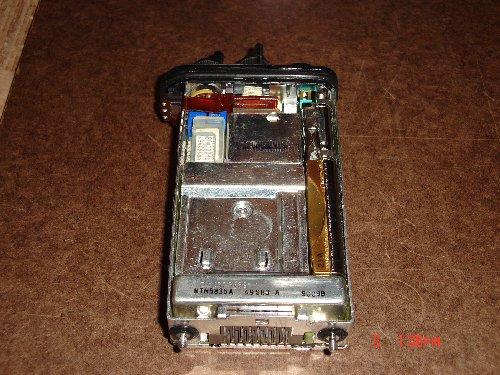
This is what it looks like without the case
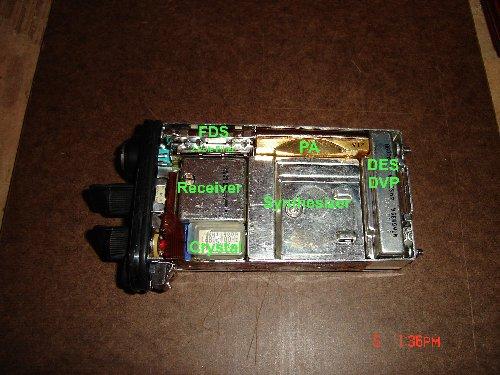
Here is is with the modules identified
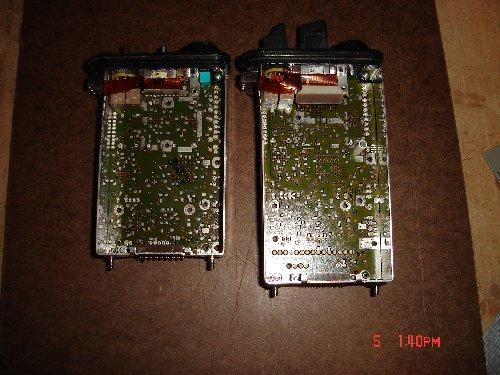
The secure capable radio is longer and uses a different motherboard and frame
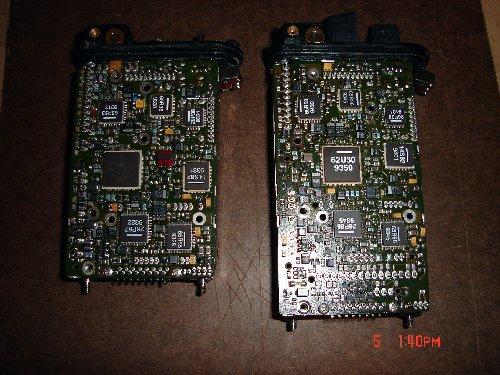
The flip side of the above picture
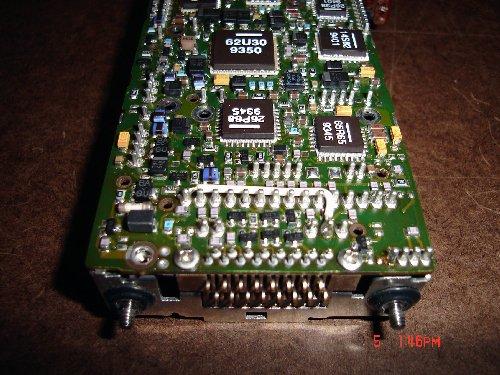
A view showing the one-wire mod that bypasses the encryption module position
About Motorola's Programming
Software / Hardware:
The RSS and RIB
Motorola's Radio Service Software, which is needed for programming and alignment of the Saber line of handhelds can be licensed and obtained on disk by calling Motorola Parts at 800-422-4210. To purchase the software license you must agree to and sign a license form attesting that you will not resell the software, distribute the software or otherwise allow it to be used by unlicensed users. And the software is not cheap. Repeater-builder has a separate web page with several in-depth articles on RSS and on the RIB, it can be found from the Motorola page. A copy of the Motorola RSS license is linked off that page.
The Part Number for Saber RSS is RVN4002K. Version 07.01.00 is the newest as of the writing of this document, with a release date of 12/13/1995. The Part Number for the Saber RSS manual is 6881062C95. The Systems Saber RSS is RVN4051F version R04.00.00, and the Systems Saber RSS Manual is part number 6881060C25. The Part Number for the license form you will be required to sign is RPX4719G. Anyone programming Sabers needs to have a copy of the appropriate programming manual, as many options for the Saber are undocumented in the software screens or the help files and have rather cryptic abbreviations and descriptions. And the help file is not THAT useful.
Note that the Saber, Astro Saber and System Saber III RSS packages are *NOT* compatible. You need to use the software specified for your radio. System Sabers have 8K of available memory that you assign as needed. Once you use all 8K, you are out of room for anything else. ALL of the programmed information goes there: Channel frequencies, scan lists, PL codes, DPL codes, MDC codes, single tone and other signaling all go in that 8K. Yes, that's what was available in a single EEPROM chip at the time the radio was designed, but 8K is really NOT enough for what this radio can or should do, and nobody has come up with a mod to replace the memory chip with a larger one, or to piggyback a second one onto the board. And if you could pack 16K into a radio you'd still have to convince the RSS to use it. And the Systems Saber / Astro Saber / Saber differences also extend to the accessories - for example, from what I have been told, the display microphone used with the SVA (mobile adapter) is different between the System Saber, Saber and Astro Saber.
The hardware required to program a Motorola Saber includes:
| I've had the same problem only I've blown two 2nd level EEproms on Saber radios while triing to write to them with anything faster than a 386. I called the local motorola rep here and asked if they have had the same problem. His reply was that they keep a XT around just for programming radios. He said that it is very slow but doesn't blow $132.00 EEPROMS. |
There are many people manufacturing RIBs and programming cables that work just as well as Motorola's branded equipment. Be sure that the RIB you purchase is guaranteed to be 100% compatible with Motorola's RLN4008.
The sections of the radio programmed by the RSS are the Internal and External COPE and the CORE Options.
Changing the Band Limits in the RSS:
The RSS can easily be hex-edited to allow out-of-band programming, rather than editing each channel individually. For example, on the 146-162 MHz and 148-174 MHz splits I moved the bottom end to 144 MHz. However, if you read a radio that is programmed as a 146-162 MHz radio it will default to such in the RSS. You have to create a new codeplug from scratch by selecting the newly available 144-162 MHz or 144-174 MHz splits, then filling it with the frequency, tone, etc, information. Once the radio has been loaded with the new codeplug (i.e. programmed with the new split) it will continue to be read as such, so you only have to do this once.
For detailed instructions on this process click here: Hex editing the Saber RSS to allow out of band programming.
Upgrading Sabers to Support Additional Features:
The CORE firmware is run by the radios 68HC11 series microprocessor. Options that are determined by the CORE version (such as QuickCall-II decode, MDC600 or MDC1200 Signaling, StatAlert and a plethora of other options that most Amateurs have no interest in, as well as the radio's scan capability) can not typically be upgraded without replacement of the CPU board. This is not usually cost effective as the CPU boards are around $100 US. The common core versions for Sabers are 5D, 6D and 8D. A 5D is a more basic CORE, a 6D is capable of QC-II Decoding and Repeater Access Tone Encoding and an 8D CORE is capable of the previous options and StatAlert. There may be additional options but these are the differences I'm aware of.
A Saber II can be upgraded to a Saber III by replacing the front panel with one that has a keypad, the DTMF Encoder and 8k of memory. The process is rather intensive and is not for the faint of heart as it requires deliberate corruption of the internal codeplug (flash memory contents) in order to convince the radio to accept programming with a Factory ID that differs from what it believes it should be. A separate tutorial will be written on this topic detailing this process in the near future.
Adding Channels to a Saber:
Method 1 (Expansion from 12 channels to 15 channels):
This is accomplished by removing the knob cover from the channel selector switch, removing the tabbed cover from the switch post, removing the metal stop tab ring from the switch by turning the radio over and tapping it on the desk and replacing the tabbed cover to the switch post and snapping the knob cover back into place. You must then add the additional channels to the codeplug file in your RSS Archive directory.
For detailed instructions on this process click here: Expanding a Saber from 12 Channels to 15 Channels.
This method will allow 15 channels in a single zone but be warned, do not fill all of the zones with 15 channels. The codeplug memory does not allocate a chunk of RAM for each channel and N times a chunk for a zone - each channel takes up a chunk and if you run out of memory you will end up with weird things happening in the radio such as duplicate channels across zones that look just fine on the RSS screens.
Method 2 (Conversion from a Saber I to a Saber IE):
A Saber IE is the same as a Secure Saber I except the clear / coded switch is used to switch between two zones of 12 channels. It also has an additional memory board in the front shield assembly. The part number for the board and connecting cable kit is NTN5686A. You would then create a Saber IE codeplug and flash it to the radio.
Manuals:
Useful manual part numbers: (If anyone has additional info please send it in)
Accessories / Antennas:
Saber Parts List and Accessories Catalog
Heliflex antennas:
Older antennas:
Does anyone have a photo showing the colored base/dot?
Summary:
The Sabers best suited to amateur radio use are the 136-150 MHz and 146-162/174 MHz bandsplits for 2m operation and the 440-470 MHz bandsplit for 70cm operation. As mentioned above, the 403-433 MHz radio will only "reach" to about 436 MHz and hence is just not capable of operation in the repeater segment of the USA 70cm amateur band.
What I look for when purchasing Sabers is ideally a Saber III
or a 120 Channel Saber II, Secure Capable (not Secure Equipped
necessarily). If you need DTMF for repeater functions, auto patch
or the like then you most certainly want a Saber III or plan on
upgrading the front panel of a II. Note that all DTMF Sabers are
12-button DTMF - Motorola never made a 16-button DTMF Saber (that
I know of). The DTMF tones are created by the main CPU and I'll
bet that the firmware has no concept of 1633 Hz.
And I've seen a tiny 16-button DTMF pad on the back of a speaker-mic
housing (not a Moto one) cabled to a Saber radio.
Other Information:
This page at www.cryptomuseum.com has some very nice Saber information.
Contact Information:
The author can be contacted at: his-callsign // at // repeater-builder // dot // com.
Up to the top of this page
Up one level
Back to Home
The Motorola and Saber names / marks are Trademarks of Motorola Inc.
Text is Copyright © 2005 and 2010 by Scott Lichtsinn KBØNLY,
Ric Letson NB2E, Skip Chestnut KC2MCV, and Duane Park N6DSP
Hand coded HTML Copyright © 2005 and 2010 by Mike Morris WA6ILQ.
All Rights Reserved, including that of paper and web publication elsewhere.
This web page, this web site, the information presented in and on its pages and in these modifications and conversions is © Copyrighted 1995 and (date of last update) by Kevin Custer W3KKC and multiple originating authors. All Rights Reserved, including that of paper and web publication elsewhere.